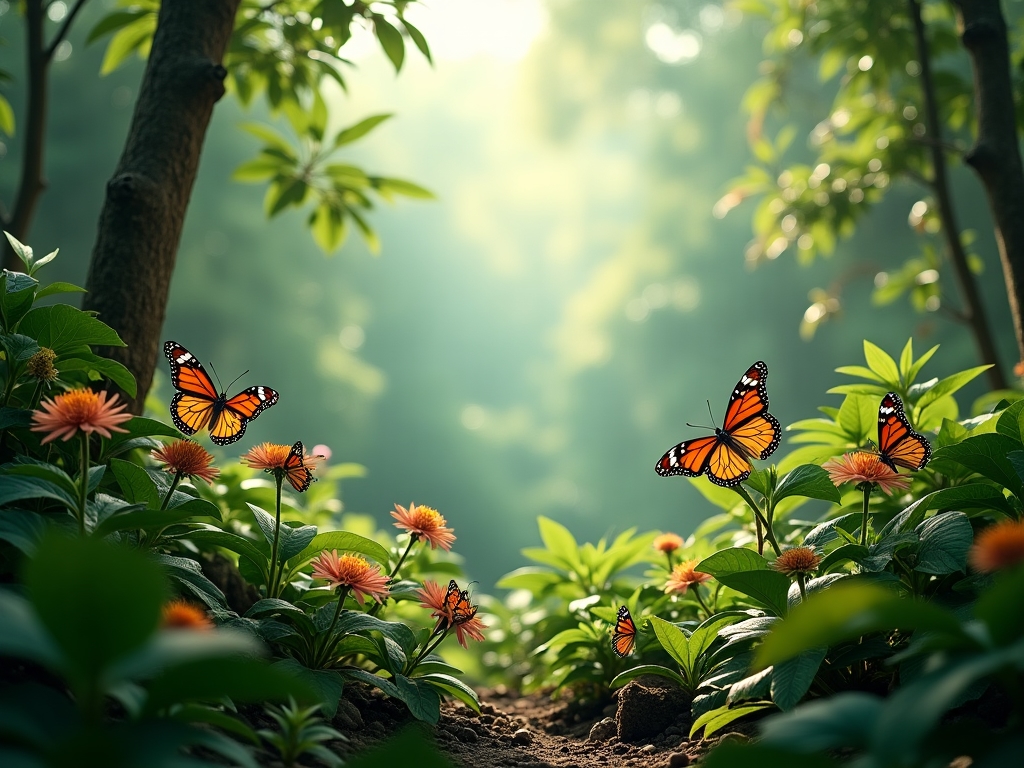For butterfly enthusiasts, finding the perfect habitat to observe these winged wonders in their natural environment is the ultimate goal. While butterfly houses and gardens offer convenient viewing opportunities, nothing compares to witnessing butterflies in their native ecosystems. This guide explores some of the world's most remarkable habitats for butterfly observation, highlighting what makes each location special and the best times to visit.
Tropical Rainforests: The Epicenter of Butterfly Diversity
Tropical rainforests represent the pinnacle of butterfly diversity, hosting more species than any other ecosystem on Earth. The combination of year-round warmth, high humidity, and incredible plant diversity creates ideal conditions for butterflies to thrive. Within the rainforest, different microhabitats support various butterfly communities.
The rainforest canopy, though difficult to access, hosts numerous species that rarely descend to ground level. Specialized canopy walkways in places like the Amazon Rainforest Research Center in Peru or the Rainforest Discovery Centre in Borneo provide unique opportunities to observe these high-flying species. Look for large, fast-flying butterflies like morphos and birdwings that patrol the canopy gaps.
Forest edges and clearings are often butterfly hotspots, as many species prefer these boundary areas where they can access both forest resources and open sunny spaces. These areas typically offer the best butterfly viewing for visitors, with species congregating around flowering plants or gathering minerals from damp soil (a behavior called "puddling").
When visiting tropical rainforests for butterfly observation, the early dry season often provides the best viewing opportunities. In the Amazon Basin, July to October typically offers good conditions, while in Southeast Asian rainforests, February to April is often ideal. Early morning hours (7-10 AM) and late afternoon (3-5 PM) typically see the most butterfly activity.
Cloud Forests: Unique Microclimates and Endemic Species
Cloud forests, found at higher elevations in tropical regions, offer a completely different butterfly-watching experience. These misty forests, often shrouded in clouds, create unique microclimates that support specialized butterfly species found nowhere else on Earth.
The Monteverde Cloud Forest Reserve in Costa Rica is among the world's premier destinations for cloud forest butterfly observation. Here, over 500 butterfly species have been recorded, including many endemics. The reserve's Butterfly Garden provides guaranteed sightings, but venturing onto the forest trails offers the chance to spot rarer species in their natural habitat.
Ecuador's Mindo Cloud Forest is another exceptional location, particularly for observing clearwing butterflies (Ithomiines) with their transparent wings that seem to disappear against the misty backdrop. The region's numerous butterfly farms not only offer close-up viewing opportunities but also support conservation efforts.
When visiting cloud forests, be prepared for rapidly changing weather conditions. The best viewing is often on partly cloudy days when sun breaks provide warming periods that trigger butterfly activity. Unlike lowland rainforests, cloud forest butterflies may remain active throughout the day due to the cooler temperatures.
Tropical Dry Forests: Seasonal Butterfly Explosions
Tropical dry forests experience pronounced wet and dry seasons, creating a dramatic cycle of butterfly abundance. After the first rains following the dry season, these forests explode with new plant growth, triggering mass emergences of butterflies that create spectacular viewing opportunities.
Costa Rica's Santa Rosa National Park showcases this phenomenon beautifully. During the early rainy season (May-June), the forest transforms from a relatively brown landscape to a green one within weeks, accompanied by an explosion of butterfly activity. Species like the Blue Morpho, which may be scarce during the dry months, suddenly become abundant.
Mexico's Calakmul Biosphere Reserve in the Yucatán Peninsula offers another excellent example of dry forest butterfly habitat. The reserve's ancient Maya ruins provide both historical interest and excellent butterfly viewing, as the cleared areas around the structures create ideal edge habitats where butterflies concentrate.
For the best experience in tropical dry forests, time your visit for the transition period between dry and wet seasons when butterfly populations peak. Early morning is essential for viewing, as many species become inactive during the intense midday heat.
Mountain Meadows: Alpine Specialists
High-elevation mountain meadows host specialized butterfly communities adapted to the harsh conditions of these environments. While these habitats may have fewer species than tropical forests, they often showcase striking adaptations and behaviors.
The alpine meadows of the Rocky Mountains in North America offer excellent butterfly viewing during their short summer season. Locations like the meadows around Mount Evans in Colorado or the Paradise area of Mount Rainier National Park in Washington state provide accessible high-altitude habitats where butterflies must complete their life cycles within a compressed timeframe.
In the European Alps, locations like the Aletsch Arena in Switzerland or the Hohe Tauern National Park in Austria offer similar opportunities to observe alpine specialists. Look for species that have evolved dark coloration to absorb heat more efficiently in the cool mountain air.
The butterfly season in mountain meadows is brief but intense. Plan your visit during the peak summer months (July-August in the Northern Hemisphere) and focus on sunny days when butterflies are most active. Unlike in tropical habitats, midday can be the best time for butterfly activity in these cooler environments.
Practical Tips for Butterfly Observation
Regardless of which habitat you choose to explore, a few practical tips will enhance your butterfly-watching experience:
- Move slowly and observe carefully—many butterflies are camouflaged when at rest
- Wear subdued colors to avoid startling these visually-oriented insects
- Bring binoculars with close-focus capability for detailed observation without disturbing the butterflies
- Carry a field guide specific to the region you're visiting
- Visit flowering areas, mud puddles, and forest edges where butterflies tend to congregate
- Consider joining a guided tour led by local experts who know where to find specific species
By seeking out these prime butterfly habitats and timing your visits appropriately, you'll maximize your chances of witnessing the incredible diversity and beauty of the world's butterflies in their natural environments. Each habitat offers a different window into the fascinating adaptations and behaviors of these remarkable insects.
